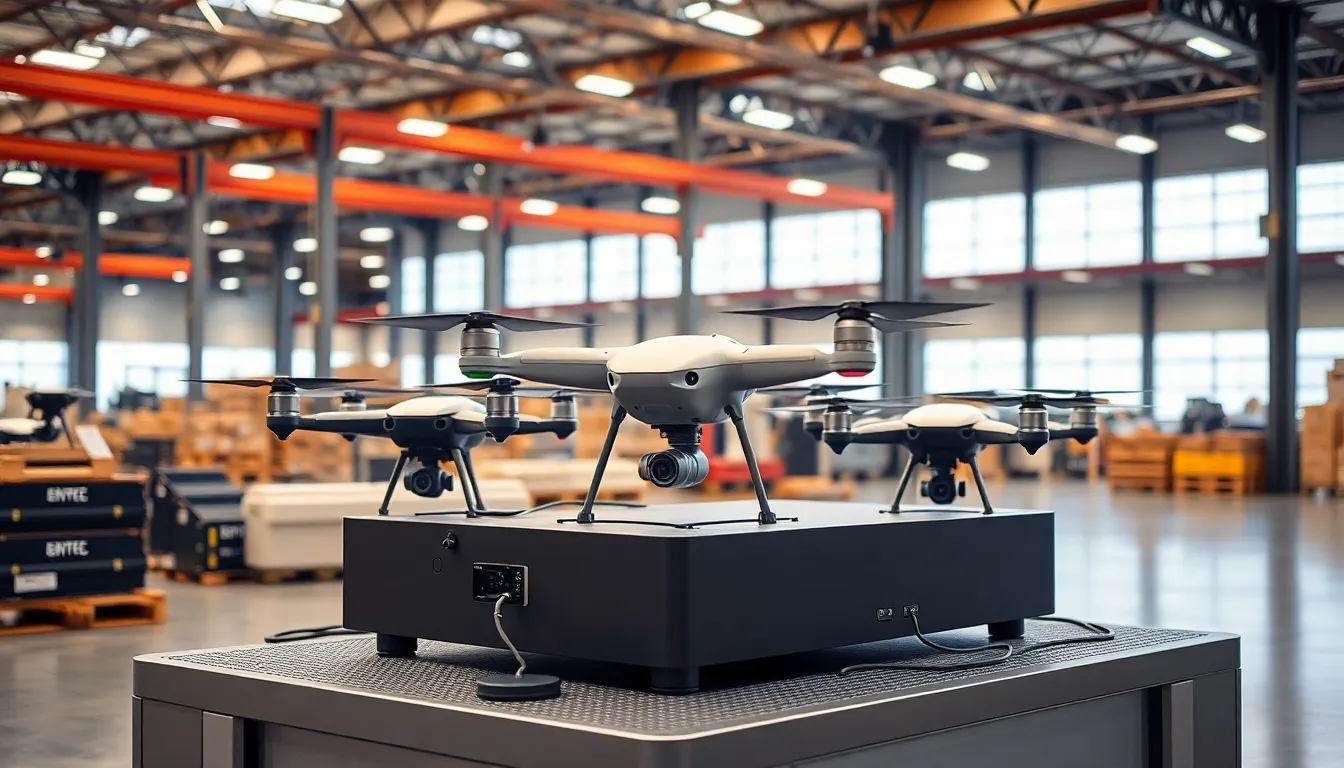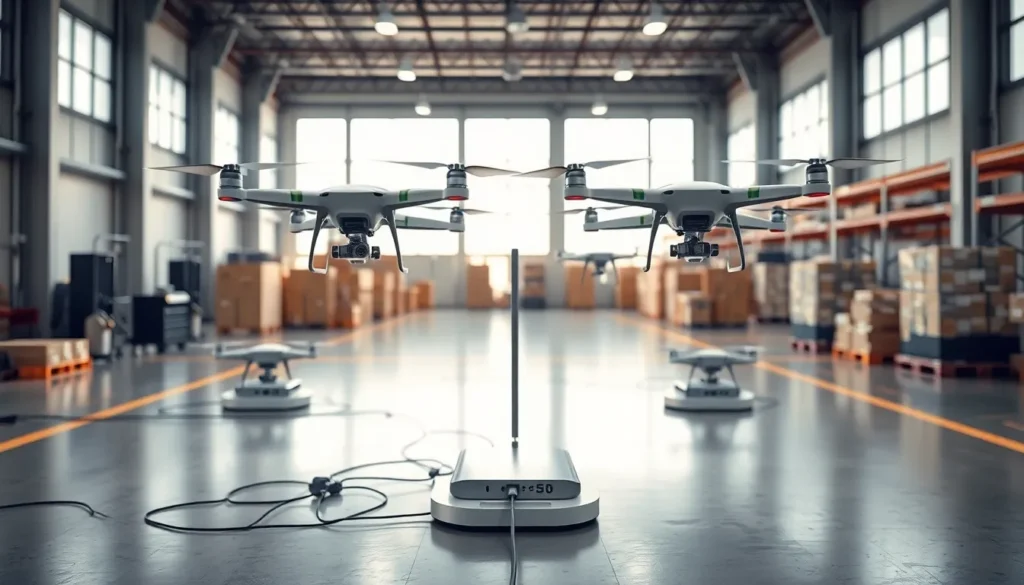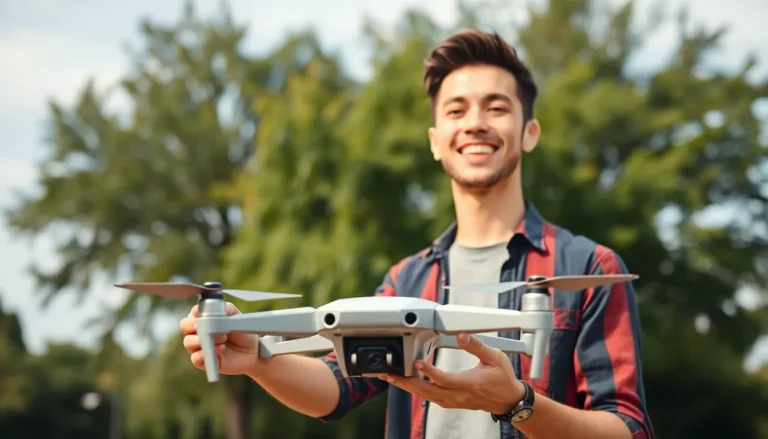Table of Contents
ToggleIn a world where drones are zipping around like caffeinated bees, keeping them powered up is no small feat. Enter drone charging stations—the unsung heroes of the skies. These nifty setups ensure that our flying friends never run out of juice mid-mission, whether it’s delivering tacos or surveying the neighborhood for rogue squirrels.
Overview of Drone Charging Stations
Drone charging stations play a critical role in the continuous operation of drones, ensuring they remain powered during various tasks like deliveries and surveillance.
Importance in Modern Drone Technology
Drones are becoming integral to industries like logistics and agriculture. Their efficiency heavily relies on reliable power sources. Charging stations provide the necessary infrastructure to support rapid deployments. Without these stations, mission readiness declines as drones face the risk of battery depletion in remote areas. In addition, optimizing flight paths and minimizing downtime makes charging stations essential for operational success in competitive markets.
Key Features to Consider
Several key features define an effective drone charging station. Quick charging capabilities significantly reduce downtime during operations. Durability ensures the station withstands varied environmental conditions. Moreover, compatibility with a wide range of drone models increases usability. Remote monitoring functionalities enable operators to track battery levels and performance. Lastly, ease of installation simplifies integration into existing systems, making these stations versatile tools for enhancing drone operations.
Types of Drone Charging Stations

Drone charging stations come in various forms, each designed to meet specific operational needs. Understanding these types is essential for optimizing drone efficiency in diverse applications.
Wired Charging Solutions
Wired charging solutions provide a straightforward method for powering drones. These systems connect directly to a drone’s battery via charging cables. Fast recharging capabilities often characterize wired stations, enabling drones to return to action quickly. It’s common for organizations to install these solutions in fixed locations such as warehouses or fulfillment centers. Compatibility with numerous drone models enhances their appeal. Maintenance on wired systems may require routine checks on cables and connectors.
Wireless Charging Technologies
Wireless charging technologies utilize electromagnetic fields to transfer energy. These innovative systems eliminate physical connections, reducing wear and tear on equipment. Drones equipped with wireless charging capabilities can land on designated pads to receive power. Many setups allow multiple drones to charge simultaneously, optimizing workflow and minimizing downtime. Emerging technologies continue to enhance the efficiency of wireless power transfer. As a result, industries benefit from greater flexibility in drone deployment. Implementing these systems supports seamless operations, particularly in dynamic environments like delivery services and agricultural applications.
Benefits of Drone Charging Stations
Drone charging stations significantly enhance overall operational effectiveness across various industries. Their integration directly correlates with improved task execution and reduced downtime.
Increased Efficiency and Productivity
Increased productivity stems from rapid recharging capabilities offered by drone charging stations. Fast charging options enable drones to complete multiple missions within a single day. Simultaneously, these stations minimize the time spent on the ground, maintaining continuous workflow. Such efficiency proves essential in sectors like logistics, where quick turnaround times are critical. By supporting multiple drones at once, charging stations ensure seamless operations that effectively meet demanding schedules.
Environmental Impact
Environmental benefits emerge through the deployment of drone charging stations. These systems promote the use of electric drones, which have a lower carbon footprint compared to traditional vehicles. Sustainable energy options, such as solar-powered charging solutions, further enhance eco-friendliness. Reduced reliance on fossil fuels translates to cleaner air and fewer greenhouse gas emissions. Overall, incorporating drone charging stations fosters more responsible practices in industries, aligning operational goals with environmental stewardship.
Challenges and Limitations
Drone charging stations face several challenges and limitations that could impact their effectiveness and widespread adoption.
High Infrastructure Costs
High infrastructure costs represent a significant barrier to deploying drone charging stations. Initial setup expenses include equipment purchases and installation fees, which can deter organizations from investing in this technology. Long-term maintenance costs also add to financial burdens, particularly for businesses operating in remote areas where infrastructure development is limited. Investing in multiple charging stations further strains budgets, especially for companies managing large drone fleets. Overall, high costs may hinder advancements in drone charging solutions and limit access for smaller enterprises.
Compatibility Issues
Compatibility issues frequently arise with various drone models and charging systems. Differences in battery sizes and charging protocols complicate the integration of charging stations with existing drone operations. Some charging solutions may only support specific drone brands, narrowing their usability. Furthermore, software discrepancies can create challenges in monitoring and managing multiple drones simultaneously. Organizations often deal with these complications by investing in multiple charging systems, which increases costs and operational complexity. Addressing compatibility concerns is essential for optimizing drone deployment across diverse applications.
Future Trends in Drone Charging Stations
Emerging trends in drone charging stations reflect the growing demands of various industries. Advancements in battery technology will likely lead to faster charging solutions. Manufacturers are exploring solid-state batteries that provide enhanced efficiency and safety compared to traditional lithium-ion batteries. Integration of AI could enable predictive maintenance, allowing stations to anticipate charging needs based on real-time data. Furthermore, the trend toward modular stations enhances scalability for diverse operations, offering the flexibility to meet specific requirements.
Innovations on the Horizon
Future innovations promise to revolutionize drone charging stations. Wireless charging capabilities, using inductive methods, may eliminate the need for wired connections. This technology could minimize wear on drones and streamline operations. Enhanced automation through robotics may allow for self-parking and autonomous charging, simplifying user experiences. Improved user interfaces with mobile app integration will likely offer seamless monitoring and control. Such innovations aim to make drone operations more efficient and user-friendly.
Integration with Renewable Energy Sources
The integration of renewable energy sources into drone charging stations presents a sustainable future. Solar-powered solutions can harness energy during daylight, reducing reliance on traditional power grids. By using battery storage systems, stations can provide power during non-daylight hours enhancing availability. Wind energy could complement solar solutions, especially in areas with consistent airflow. These integrations not only lower operational costs but also promote environmentally responsible practices aligning with corporate sustainability goals. Adaptations like these will shape the future of drone operations, aligning efficiency with ecological stewardship.
Drone charging stations are pivotal in enhancing the efficiency and sustainability of drone operations across various industries. By providing reliable power sources, they enable drones to perform multiple missions with minimal downtime. As technology continues to evolve, advancements in charging solutions promise to address current challenges, making these stations more accessible and effective.
The integration of renewable energy sources and innovative charging technologies will not only optimize operational performance but also promote environmental responsibility. Embracing these developments will position organizations to harness the full potential of drones, ensuring they remain at the forefront of modern logistics, agriculture, and beyond.







